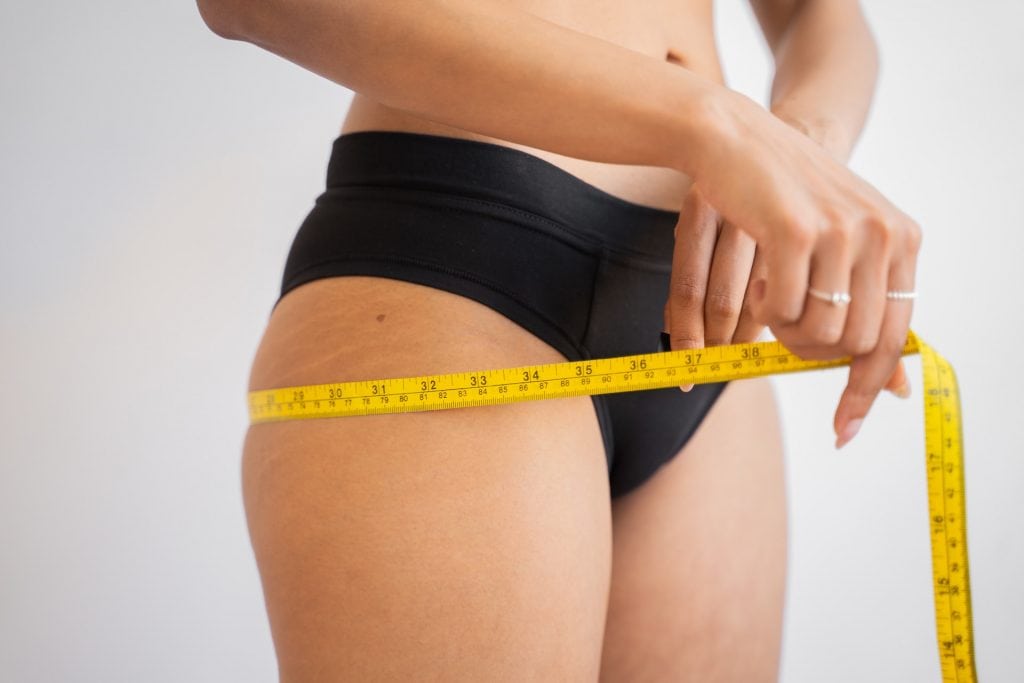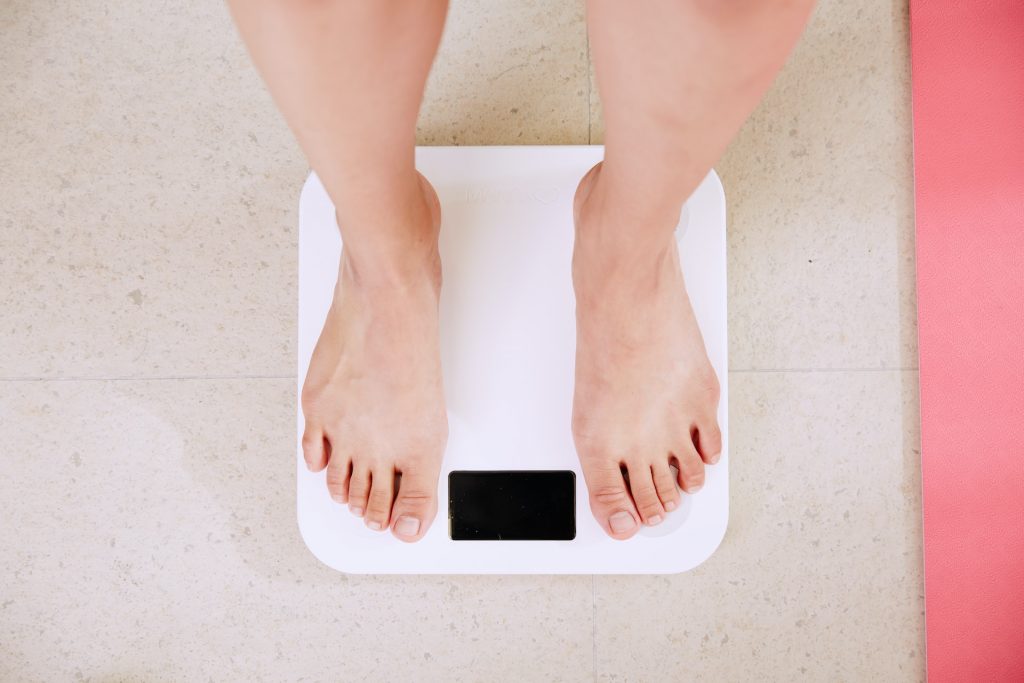Are you losing inches but not weight? I know that this is frustrating but it’s 100 percent normal.

Standing on a scale isn’t the most efficient way to measure your weight loss goals and just because the number on the scale is staying the same, doesn’t mean you aren’t making progress.
So in this post, I’ll cover six reasons why you’re losing inches but not weight and what you can do about it.
You’re Losing Water Weight
The most common reason why people lose inches but not weight is water retention. When you lose weight, you retain a lot of fluid. You can lose up to five pounds in your first few weeks of working out and suddenly stall.
If you aren’t aware that this is all water weight, you’ll be frustrated when you stop losing weight.
During this time, people think that their diet or training principles aren’t working, and they quit.
So if you lose a lot of weight at the beginning of your weight loss journey and stall unexpectedly, understand that this is normal.
You’re Building Muscle

The problem with scales is that they weigh your entire body, not just your body fat.
This is another reason you’re losing inches but not weight. You’re building muscle and losing fat at the same time and since muscle is heavier than fat, just a little bit of muscle can increase your body weight.
This is a good thing because there’s more to overall health than a number on a scale.
Also, research shows that muscle can help you lose weight. It doesn’t burn fat directly, but carrying more muscle around raises your body’s resting metabolism rate, making fat loss easier.
So although it might be tempting to reduce resistance training to lower your weight, a better long-term approach will be incorporating weight lifting with cardio and a clean ketogenic diet. This promotes good body composition.
You’ve Hit a Weight Loss Plateau
Weight loss plateaus suck, but it happens to all of us when our body gets used to our training routines and diet habits. The best way to combat this is to reassess your habits and see if there are any areas where you’re slowing down. For example, maybe your cheat meal contains too many calories, or you’re skipping days in the gym.
From here, create a plan of action where you’re solving these issues. Maybe you could implement a yummy diet plan where you don’t need a cheat meal. Or maybe you can start running a few miles every morning.
Another way to defeat a weight loss plateau is to reduce calories. If you lost 30 pounds, but your calorie intake is still the same as when you started your weight loss journey, you can expect a drop in progress. Instead, cut down your calories and see if you continue losing weight.
Your Bone Density Increased

Most people don’t realize it, but when you start working out, you increase bone density, which significantly contributes to weight gain.
Your bone density is the number of minerals in your bone, and medical papers show a strong correlation between bone density and weight gain.
But increased bone density is healthy because it reduces injuries and improves posture. It can even decrease the likelihood of developing osteoporosis later on in life.
It’s difficult to tell if your increased weight is due to bone density. But if you’ve been working out for a while and notice that your joints don’t experience the usual pains, there’s a chance bone density contributed to your weight loss plateau.
You’re Experiencing Training Inflammation
If you just started a new workout routine, training inflammation could be another reason for losing inches but not weight.
Training inflammation occurs when you’re doing high-intensity workouts. Your muscles experience micro tears, also known as exercise-induced muscle damage and this helps your muscles grow by triggering inflammation.
However, this inflammation causes your body to hold more water weight, which increases your body weight by a few pounds.
Fortunately, inflammation-induced weight gain is only temporary and should go away as your body gets used to your workouts.
You’re Weighing Yourself Inconsistently

Your body weight fluctuates during the day depending on factors like food intake and water retention.
For the most accurate results, weigh yourself at the same time. I like weighing myself first thing in the morning as I have nothing in my stomach. However, the time doesn’t matter as long as you’re constantly weighing yourself at the same time every day.
I also noticed that your weight can change depending on where you place your scale. Your floor’s material and angle can all add or remove a few pounds. So always weigh yourself in the same area.
What Should I Do Instead?
Here are two tips you can use if you’re feeling frustrated about losing inches but not weight:
- Stop weighing yourself every day
- Keep training and staying healthy
Stop Weighing Yourself Every Day
The most common reason why people find themselves losing inches but not weight is that they weigh themselves daily. If you expect to see a difference on the scale after a few days, you’ll be disappointed since weight loss doesn’t work like that.
Some days you’ll see a noticeable loss in weight, while on others, you’ll pick up weight.
So I’d suggest weighing yourself every two weeks to avoid getting hung up on small weight fluctuations.
Keep Training and Staying Healthy
Many dieters will lose inches but not weight, think they’re making zero progress, and quit. This is the biggest mistake you can make because you’re making progress; the scale just can’t pick it up.
If you’re thinking about giving up, know that if you’re eating at a calorie deficit and hitting the gym a few times per week, you are making progress. Consider using an alternative weight loss measurement like body fat percentage or progress pictures. It’ll keep you motivated when the number on the scale stalls.
Alternative Ways to Measure Weight Loss
Weighing yourself isn’t the only way to track weight loss progress. In fact, it’s one of the most inaccurate methods as it’s susceptible to water retention and increased and muscle mass. So instead of obsessing over your body weight, opt for these alternative weight loss measurements:
- Measure your body fat percentage
- See how your clothes fit
- Take progress pictures
Measure Your Body Fat Percentage
Measuring your body fat percentage is the best way to see if you’re losing fat. Body fat measurements aren’t susceptible to water retention, increased bone density or muscle mass.
The most convenient way to measure your body fat percentage is with a body fat caliper. These instruments only cost a few dollars, and you can get them at your local pharmacy. But although it’s an accurate way to measure body fat, it does require some skill and knowledge. If you don’t know how to use it correctly, it can produce inconsistent results.
So if you’re looking for a more accurate reading, use DEXA scans. This finds your exact body fat percentage, and there are almost zero margins for error. Also known as hydrostatic weighing, DEXA scans occur when you’re submerged underwater to measure your body’s fat density.

See How Your Clothes Fit
You can also measure progress through clothing size. If you’re losing inches but not weight, you’ll notice that your clothes will fit more loosely, even if your weight stays the same.
So if you’ve been working out for a few months and dropped from a size 14 to a size 12 jeans, use it as motivation because you’re smashing your weight loss goals.
Take Progress Pictures
The last alternative to weighing yourself is to take progress pictures every three weeks because it allows you to see how your body has changed over a long time period. You might not see a difference by looking at yourself in the mirror daily. But if you compare your physique to a few months ago and see a positive change, you’re making progress.
Final Thoughts on Losing Inches but Not Weight
The most common reasons why people lose inches but not weight is because of water retention, increased muscle mass or bone density, weight loss plateaus or you’re weighing yourself inconsistently.
If you’re losing weight but not inches, consider switching up your measurement of weight loss. Scale weight doesn’t account for muscle mass and water retention, so try measuring your body fat percentage, taking progress pictures and seeing how your clothes fit.
Written by
Matt Gaedke
Matt is a former college basketball player turned computer engineer who discovered his passion for health and nutrition after cutting sugar from his diet in 2016. That year he founded KetoConnect with Megha in order to share their ketogenic lifestyle through recipes, videos, and educational content. Matt is always seeking to grow and try new things, a passion he shares with his wife and two amazing sons.

